Can you spot the tiny, deadly Irukandji jellyfish?
Aussie lifeguards have shared a terrifying clip of a deadly jellyfish next to a $2 coin in a bid to highlight just how tiny the venomous creature is.
An incredible video shows just how tiny Australia’s extremely venomous Irukandji jellyfish can be.
Lifeguards in Far North Queensland who have a permit to use special drag nets to catch the dangerous stingers filmed a comparison video with a $2 coin.
“This is what we mean when we say Irukandji really are THAT small!” they wrote on their Instagram page, fnqlifeguards.
The jellyfish, one of the most venomous in the world, was collected at tourist favourite Palm Cove, north of Cairns, in December. It was about half the length of the gold coin.
Its small size should not fool you; the sting from an Irukandji jellyfish can be life threatening as it can cause very high blood pressure or heart complications.
Symptoms may take up to 40 minutes to develop and include severe generalised muscular pain, headache, vomiting and sweating.
The high-risk marine stinger season runs from November to May in northern Australia, with tourists and locals urged to swim between the red and yellow flags, in dedicated stinger net areas, and to always wear a full-body stinger suit.
“It might not be the trendiest look but it’s your best protection against these harmful stings,” a lifeguard warned in a Surf Life Saving Queensland safety video last month.
Another lifeguard added: “When it comes to stingers, remember, just because you can’t see them doesn’t mean they’re not going to be there.
“If you do get stung, please let us know right away so we can help with medical care.”

Sydney man Will Willitts was hospitalised in Cairns after being stung by a Irukandji jellyfish inside the net at Palm Cove last summer.
“Just as we were getting out of the water, I felt something on my left butt cheek, and said ‘Oh, I’ve been stung’. Swimming in Sydney, I’m used to bluebottles. But this was stronger than a bluebottle sting,” he recalled.
Later at his accommodation he felt hot before he started vomiting, shaking and struggling to breathe. He was rushed to hospital by ambulance.
“I didn’t think I was going to get to the hospital in time. I was terrified,” Mr Willitts said.
“At one point lying on the floor, shaking and fighting to breathe, I thought ‘this is it, I’m going to cark it.’”
Fortunately, he was treated with medication and discharged from the hospital later the next day.

If you think someone has been stung by a Irukandji jellyfish, Surf Life Saving advises to pour vinegar onto the sting for at least 30 seconds and monitor the person for 45 minutes in a safe location out of the water. First aid should be administered and an ambulance called.
People viewing the video were shocked at how small the dangerous jellyfish could be.
“Wow. That’s insane in such a big ocean, something so small could be so deadly,” one person wrote.
“Woah!!! Not a hope of spotting that when you’re in the water,” said another.
“Crazy how something that small can end you very quickly,” wrote someone else.
“So small and delicate yet so incredibly dangerous,” agreed a fourth.






